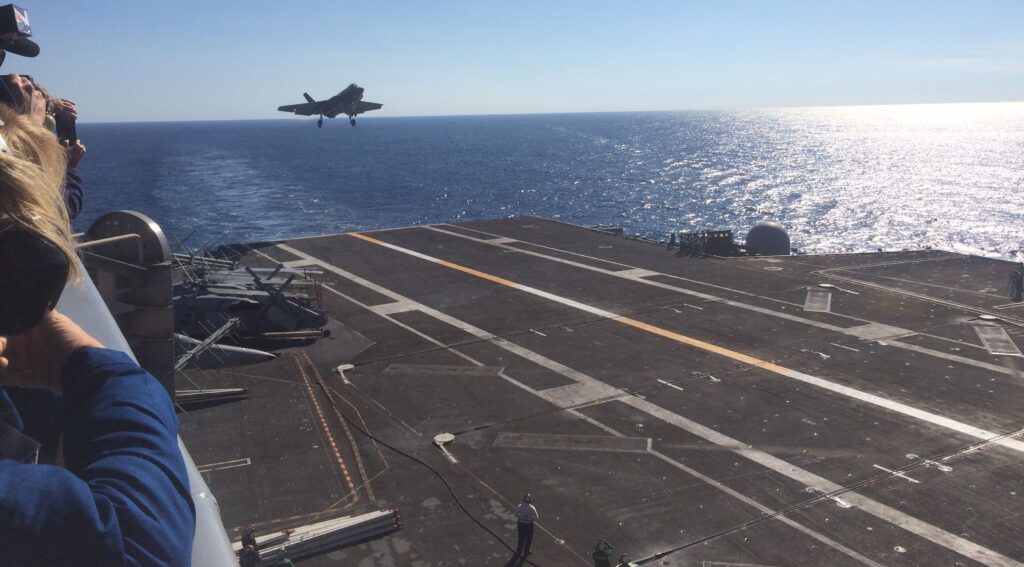ABOARD USS NIMITZ: The first F-35C seemed to float through the air toward the slowly pitching deck of the USS Nimitz, looking as if it was hanging by a wire and heading implacably to the ship’s arresting wires. The weather was gorgeous, with the massive carrier sailing some 40 miles off the San Diego coast through small swells and under gorgeous cloud-scudded cerulean blue skies.Navy's newest fighter makes first carrier landing - CNN.com
The F-35C’s wings didn’t wobble at all on final approach as test pilot Cdr. Tony “Brick” Wilson guided her in. And on its first try the plane’s tail hook grabbed the third arresting wire — the catch most favored by Navy pilots — at 12:19 pm. When an F-18 Hornet landed minutes later, the plane’s wings twitched slightly up and down on its approach and the pilot snagged the fourth wire, second to the bottom in the Navy hierarchy of carrier landing awards.
Then the second F-35C test plane came in just as steady and firm as the first. It also snagged the third wire, sending a clear message to the Navy’s aviation community that the Lockheed Martin plane not only could handle carrier landings, but could execute them with aplomb.
CNN) -- A combination of old and new hooked up off the coast of San Diego Monday to give the U.S. Navy a glimpse into its future.
The moment was the first arrested landing aboard an aircraft carrier for the military's new Joint
Strike Fighter, the F-35C Lightning II. An arrested landing means the jet was brought to a stop using a tailhook grabbing a wire stretched across the carrier's deck. The wire is attached to a gear system that brings the plane to a stop.
Strike Fighter, the F-35C Lightning II. An arrested landing means the jet was brought to a stop using a tailhook grabbing a wire stretched across the carrier's deck. The wire is attached to a gear system that brings the plane to a stop.
F-35C shines in first carrier trials aboard carrier Nimitz
US Navy F-35C jet successfully conducts maiden night-flight - Naval Technology
The US Navy's F-35C Lightning II carrier-variant joint strike fighter (JSF) has successfully completed its maiden night-flight on USS Nimitz (CVN 68), off the San Diego coast.Redesigned Tailhook Tests Well In F-35 Sea Trials | Defense content from Aviation Week
Being tested as part of a two-week initial at-sea developmental testing I (DT-I), two aircraft have already complied with 95% of the requirements for the first of three at-sea test phases scheduled for the F-35C, further validating their reliability and performance.
Reuters quoted the F-35 programme office as saying that the jets had completed more than 101 catapult takeoffs, 214 planned 'touch and go' landings and 104 arrested-landings through a redesigned tailhook on the USS Nimitz.
The latest test follows the successful completion of the F-35C's first-of-its-kind arrested-landing on the navy aircraft carrier earlier this month.
Unlike conventional carrier aircraft, in which the pilot approaches the carrier with flaps set at a fixed position and adjusts power and pitch attitude to stay on the glideslope, the F-35 system controls power through an “auto-thrust” function and alters the position of the trailing edge flap in response to pilot inputs. “So the stick becomes my glideslope controller,” says Dyckman, the second F-35C test pilot to make a carrier landing. “If I pull back, the flap adds lift; if I push forward, it commands a steeper approach.” The nominal flap position for a carrier approach is 15 deg., or half-flap, providing ample margin for additional flap movement to add or reduce lift. Wilson says the effect is to “change the ‘heave’ of the aircraft, rather than the pitch.”
“I was watching the angle-of-attack indicators,” Senior Chief Petty Officer Alistair McIntyre says. “As they came in [to land] from the break, it was perfect green all the way in. It was stable all the way in for both approaches. I was amazed for that, being their first time landing on the carrier, as it looked like both pilots were old pros at landing F-35s. They came in on the glideslope and landed with no problems. It felt like we’d been doing this for a long time.”

No comments:
Post a Comment